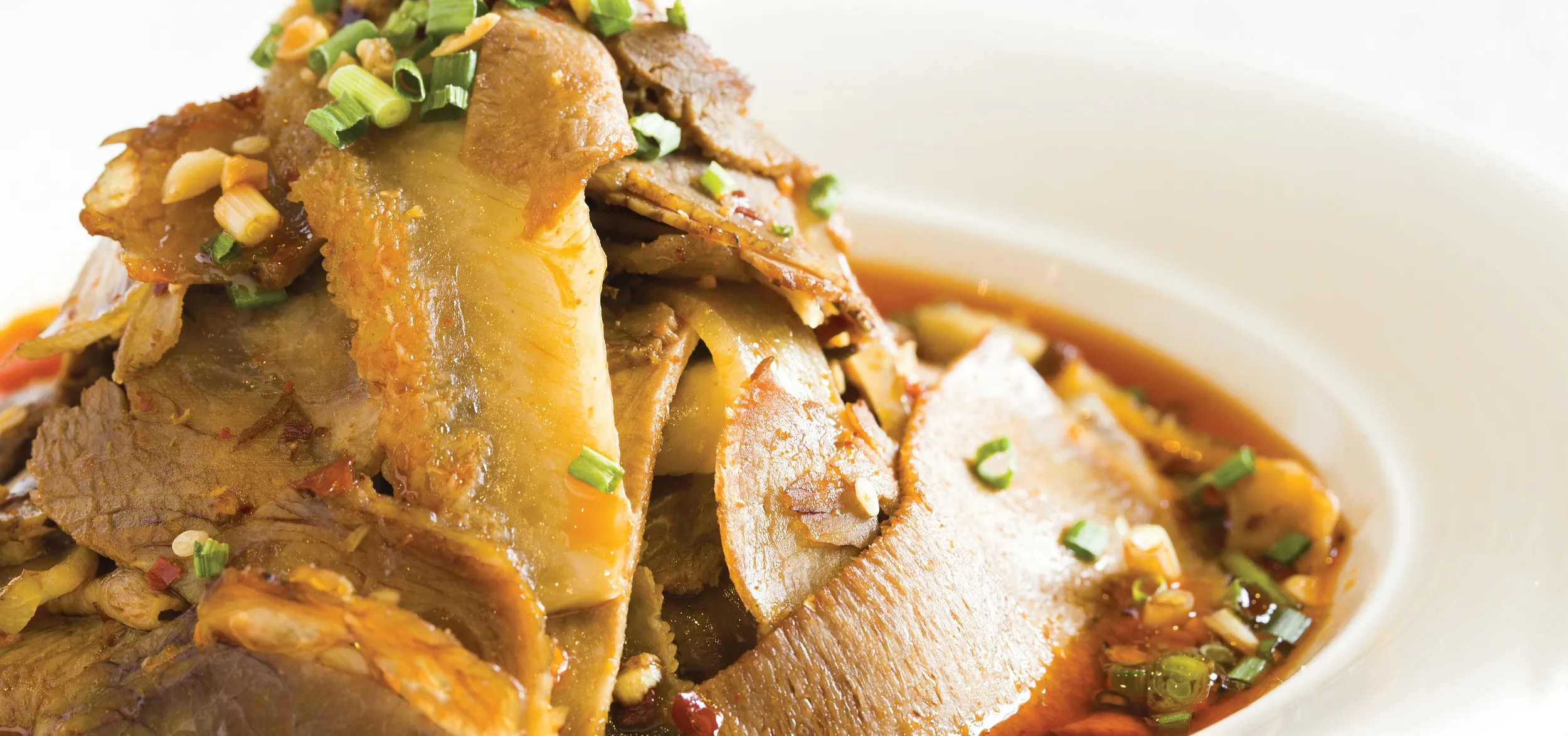A classic Sichuan starter is now winning plaudits abroad
“A numbing, burning, textural masterpiece, and the kind of thing a budding empire is built on” was how GQ food critic Brett Martin described his “Appetizer of the Year” in the US magazine’s April issue.
Chinese readers may not immediately recognize the Sichuan dish from its American name—Pepper Twins, the Houston restaurant where Martin ate, calls it “Mr. and Mrs. Smith,” after the Hollywood action-comedy starring Brad Pitt and Angelina Jolie—but foodies can probably guess that Martin was referring to the classic fuqi feipian (夫妻肺片), a name that literally means “husband and wife lung slices.”
A more descriptive translation should be “sliced beef and ox tongue in chili sauce,” because, despite the gory nickname, fuqi feipian has nothing to do with human flesh, or even lung for that matter. The appetizer consists of thinly sliced beef and organs (usually cow heart, tongue, or tripe; actual lung is rarely used), served cold—and spicy.
According to food legend, during the late Qing dynasty, many vendors sold cold beef on the streets of Chengdu, Sichuan’s capital. The slices were popular with low-income residents, like rickshaw drivers and students, and organs were often used because they were cheap. One married couple, Guo Zhaohua and wife Zhang Tianzheng, grew famous for their version, which used inventive marinating techniques, mostly to disguise the fact that the ingredients were not exactly premium parts of the cow.
Business boomed, and people began calling it “夫妻废片,” or “husband and wife waste slices,” after its creators. The couple agreed this was a good name, apart from the “废片” (waste) part, so changed it to the homonym “lung slices” (肺片), since lung could be used in the dish. One satisfied merchant was said to have given the couple a gold plaque, with the name inscribed, to decorate their shop.
When later cooks started using beef tongue and other tastier cuts, the name stayed, even though some dislike its colloquial character: In 2012, a professor at the Beijing Foreign Studies University published a 170-page state-backed book of standardized menu names to “promote Chinese culture,” calling out fuqi feipian as “one of the most horribly translated names in Chinese cuisine.”
But for most people, the odd name is the best part of the dish, which is now a mainstay on Chinese menus—as well as a good introduction to the strong ingredients for which Sichuan cuisine is known, such as garlic, chilies, anise, and, most distinctively, Sichuan peppercorn. The latter has a unique numbing quality which, when fried in hot oil, exudes a floral aroma, arousing the taste buds.
The award-winning Twin Peppers variety uses beef tendon and tongue, doused in sesame paste, peppercorns, scallions, and chili, but other versions add vinegar or garlic. Chefs say the real trick is to use cheaper cuts that are not traditionally prized, such as tendon or tongue, and blend them with fresh, flavorful ingredients to create a surprisingly refined appetizer—one that stimulates the appetite as much as it satisfying it.
Ingredients:
- 250g beef
- 250g organs (heart, tongue, tripe, as you like)
- 1 beef bouillon cube
- 10g ginger
- 5g cinnamon
- 1 star anise
- 30g Sichuan peppercorn
- 5g ground black peppercorn
- 5g sesame seeds
- 40g cooking wine
- 30g chili oil
- 10g black vinegar
- 10g light soy sauce
- 10g minced scallions
Steps:
- Rinse the beef and organs. Cut into chunks, then add to boiling water. Reduce heat and cook at a medium heat, until the color turns a light red. Remove the meat and discard water.
- In a pot, add the meat, water (as needed), the cooking wine, cinnamon, star anise, beef bouillon cube, ground black peppercorn, and ginger. Bring to a boil, stir regularly then simmer on low heat for two hours until tender. Transfer the meat to a cutting board, allowing it to cool down before slicing.
- Discard the “hard” ingredients, like the cinnamon, star anise, and ginger. Keep a small cup of the broth in reserve.
- Add the Sichuan peppercorns to the pot and warm over a medium heat until fragrant. Turn off the heat, then add the reserve liquid. Mix well with the chili oil, black vinegar, and light soy sauce. Set this aside as dressing.
- Slice the beef and organs thin. Transfer them to a serving bowl and pour the dressing over. Garnish with toasted sesame seeds and minced scallion. Serve cold and enjoy!
Husband and Wife Lung Slices is a story from our issue, “Down to Earth.” To read the entire issue, become a subscriber and receive the full magazine.












